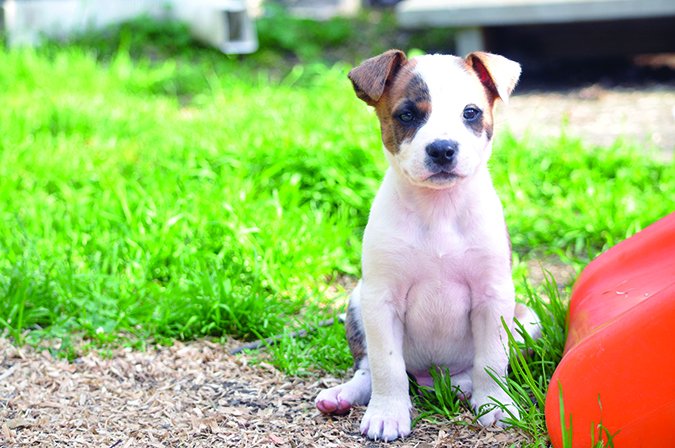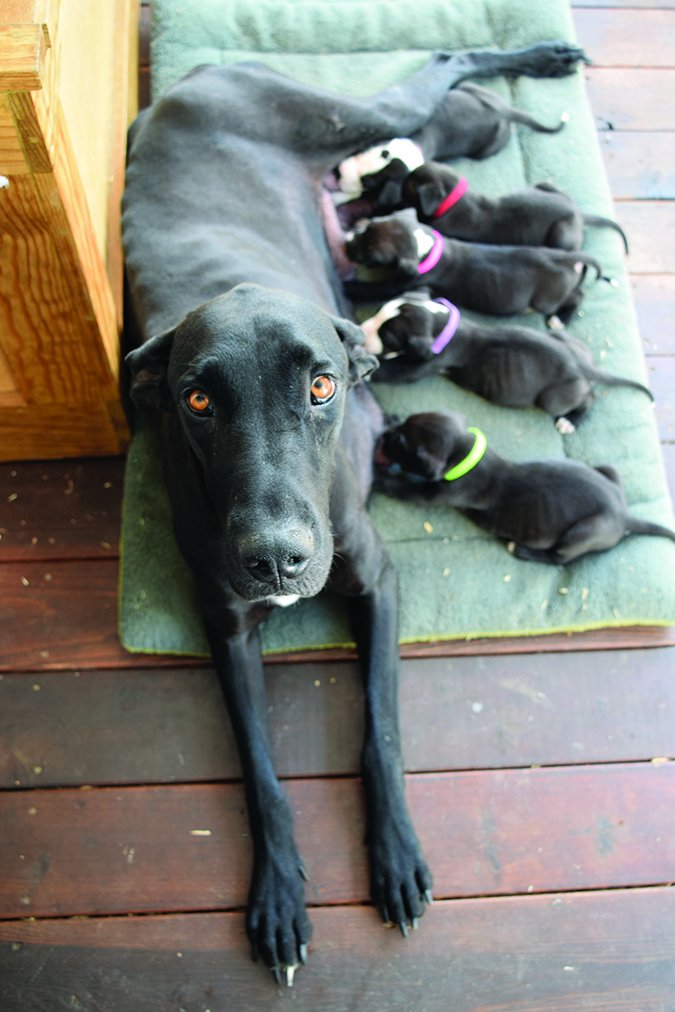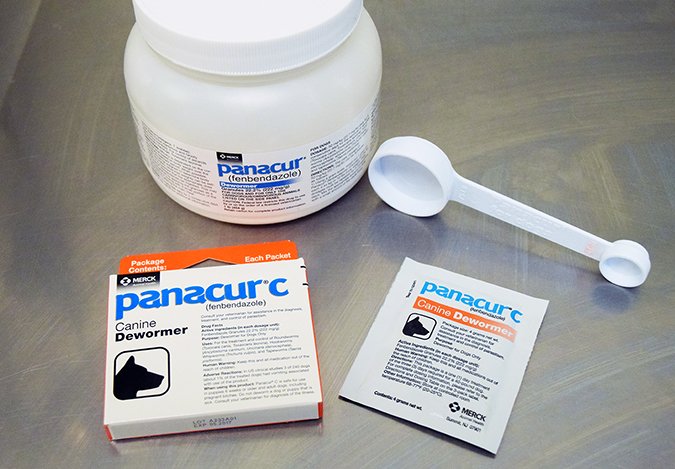The new puppy is finally here! He’s cute and fun. You just wish the diarrhea would end, figuring it’s the stress of the transition to a new home. Maybe. But probably not, and the longer you wait before seeking veterinary help, the more difficult it may be to end the cycle.
It’s not uncommon for dogs coming from group environments to have parasitic infestations, and that doesn’t necessarily mean you got the dog from a “bad” facility. Parasites survive by being difficult to eradicate and easy to spread from dog to dog.
Two of the most frustrating but common parasites your puppy might be hosting are Giardia and Coccidia. These are not worms, but two species of protozoa – single-celled organisms that reproduce in the intestines of infected animals and shed their spores into the environment through the infected animals’ feces. These spores can survive in watery environments and soil, long enough to be incidentally consumed by other animals, either by drinking contaminated water, eating contaminated grass, or just walking through (or sitting or lying on) contaminated soil and then grooming themselves.
Once inside an animal, the spores find a home within the cells of the intestine and reproduce, starting the cycle all over again. Infections can be extremely difficult to eradicate from the environment.
These parasites are commonly found in rescues, kennels, and daycare facilities, mainly because it is so difficult to end the life cycle. Wild animals can transmit giardia, too. And Coccidia have been found to “travel,” thanks to birds giving them a ride to a new location.
For this reason, “I advise my clients to do a fecal test on every new puppy or dog that comes into your home,” says Eileen Fatcheric, DVM, of Fairmount Animal Hospital in Syracuse, New York. If your new puppy was experiencing diarrhea for days or weeks before you sought diagnosis and treatment, the protozoa can readily establish a foothold in your yard, making reinfection a risk.

Giardiasis in Dogs
Giardiasis is the disease caused by an infection of Giardia parasites. Giardia organisms spread through the dog’s contact with contaminated feces, which may be in water, on grass, on other animals – anywhere in the dog’s environment.
The protozoa are ingested by your dog while in the form of cysts, analogous to fertilized eggs that are waiting for the right conditions to develop. Once inside the dog, the cysts open up and release a flagellate form (trophozoite) of the organism, which use their whip-like appendages to migrate to the small intestine, where they multiply. They continue to move into the colon, where they enter the cyst form, waiting for release in the dog’s feces. Incubation is five to 14 days after ingestion.
Although both the cyst and the trophozoite forms can be released in the dog’s feces, only the cyst can survive out of the host. Humidity and crowding favor their survival, but the hardy Giardia have been noted to survive for months in cold water.
The presence of Giardia in the gut causes the intestinal epithelial barrier to lose proper function, although scientists are still trying to figure out the precise biochemical mechanisms responsible for this. Interestingly, Giardia causes disease without penetrating the intestinal epithelium, invading the surrounding tissues, or entering the bloodstream. Fortunately, the disturbance to the epithelium resolves quickly when the parasite is cleared from the dog with appropriate treatment.
Coccidiosis in Dogs
Coccidiosis is the disease caused by a Coccidia parasite. Coccidia are spore-forming protozoan. They are extremely hardy, withstanding even freezing temperatures, and can exist in the environment for a very long time. Dogs pick up the protozoa through ingesting contaminated feces (either by eating feces, or stepping or laying in it and later licking their feet or fur); ingesting an infected animal, such as a rodent; or eating or drinking from a contaminated source. Birds can pick up infected feces and spread it to far-reaching areas.

The dog ingests the Coccidia as immature oocysts. Once inside, the oocysts release sporozites that invade the cells of the intestinal lining, where they reproduce rapidly and cause destruction of those cells. As the sporozites reproduce, more oocysts are released into the environment to be picked up and spread to another host.
Unlike Giardia, whose method of damaging the intestinal epithelium is still unknown, Coccidia have a clear, physically destructive affect on the lining of the intestine. Infection with this protozoa causes even more dramatic diarrhea – explosive, uncontrollable diarrhea! – than Giardia. Left untreated, coccidiosis is far more dangerous than giardiasis, as it can lead to damaged intestinal lining, severe dehydration, and death.
Who is At Risk for Coccidiosis and Giardiasis?
Coccidia and Giardia are fairly common in puppies, and immune-compromised adults are susceptible to either infection. Giardia is frequently seen in adult dogs, but healthy adult dogs readily develop a natural immunity to Coccidia. Some adults can be hosting an infection without any symptoms at all, so if one of your dogs is infected, it’s important to have them all tested and treated to prevent them from shedding the oocysts into your environment and threatening any visiting dogs or puppies with infection.
“If a dog comes into the clinic with diarrhea, we always test for these parasites,” says Dr. Fatcheric. “They’re common, highly contagious and often found in kennels and rescue facilities.”
Many dogs are found to be infected with both protozoan species Prognosis for both infections is generally good, if caught early and treated properly and the environment – inside and outside – is properly decontaminated.
Diagnosing a Coccidia or Giardia Infection
The most common symptom of an infection of either protozoan parasite is diarrhea. Given that there are so many things that can cause diarrhea in puppies and dogs, veterinarians will often ask whether the suffering canine has shown any other symptoms, including, loose or watery feces, dehydration, nausea, vomiting, gas, weight loss, or apparent abdominal pain.
Some infected dogs, however, will exhibit none of these – just persistent, sometimes intermittent diarrhea. This symptom alone warrants a harder look at that feces! Call your veterinarian’s office and ask if you can bring in a stool sample for testing. Your vet will likely want to see your puppy at the same time you bring in a sample, but if your dog is an adult and has been seen by his vet recently, she may run tests on the stool before asking you to bring him in.
You should bring a fresh feces sample, less than 24 hours old and not dried out. You don’t need to collect the entire stool; a teaspoon to a tablespoon of feces is enough! Ideally, use a small Ziploc bag to collect a small amount of your dog’s stool; a doggy poop bag is fine, but something that seals the odor in the bag is much more considerate. Refrigerate any sample that you plan to take to the vet later that day or the next day (another reason to use a bag that seals tightly!).
The first test that is usually performed is a fecal flotation or centrifugation fecal flotation. In the former, some of the feces is mixed with a solution that helps any parasite eggs or cysts float to the top; after a few minutes, a microscope cover slip is then touched to the top of the solution. Any parasite eggs or Giardia or Coccidia oocysts present will stick to the glass, and will be visible under a microscope. In the latter, the sample is mixed with a solution and then spun in a centrifuge to help the parasite eggs or cysts rise to the top.
When the cysts are present in your dog’s feces, these low-tech tests will find them. But negative results for these tests do not mean your dog is clear of infection. Not all feces that comes out of your dog will contain the cysts, even if he’s infected with one of these protozoan pests; they are shed intermittently, as the organisms reproduce. So, if your vet still suspects giardiasis or coccidiosis, she will likely run another, higher-tech test.
Giardia can be detected with an in-house SNAP ELISA (enzyme-linked immunosorbent assay) test, which is highly effective in detecting Giardia, or a fecal IFA (immunofluorescence assay) test. The latter test is usually done at an outside lab and results may take a couple of days.
For suspected infections of Coccidia that do not show on a flotation test, your veterinarian may request a PCR (Polymerase Chain Reaction) assay, which is a reliable but more expensive procedure.
Or, your veterinarian might just recommend that she treat your dog for a suspected infection; a positive response to treatment confirms the presumptive diagnosis.
Can I Get Giardia From My Dog?
If you’ve witnessed your puppy or dog suffer with diarrhea that was diagnosed as giardiasis or coccidiosis, you may be especially concerned about any tummy upset of your own, or in a member of your family. You should take comfort from this: The protozoa infecting your canine are not the same species as the type that can infect and make humans sick.
Giardia is considered zoonotic, meaning it can be found in humans, too, although if you get it, it’s probably not from your infected dog. According to the Centers for Disease Control, “the risk of humans acquiring a giardia infection from dogs or cats is small. The exact type of giardia that infects humans is usually not the same type that infects dogs and cats.”
According to Susan E. Little, DVM, and Emilio DeBess, DVM, authors of “Canine Protozoa,” (Today’s Veterinary Practice, September/October 2013), “human giardiasis contracted from a dog has not been conclusively demonstrated in North America.”
For those who have contracted it, the source is usually contaminated water. Human symptoms are similar to that of dogs.
Coccidia can infect all mammals, some birds, some fish, some reptiles, and some amphibians – but the four species of Isospora coccidia that are known to infect dogs (Isospora canis, I. ohioensis, I. neorivolta, and I. burrowsi) are not known to infect humans. Almost all coccidia infections in animals are specific to their own species.
Treating a Coccidia or Giardia Infection
Although there are no FDA-approved treatments for canine giardiasis, most veterinarians use metronidazole (Flagyl) for five to seven days, and/or fenbendazole (Panacur) for three to five days, and then re-test. The usual broad-spectrum dewormers won’t work on Giardia. Metronidazole is an antibiotic and anti-diarrheal often used to treat inflammation of the large intestine. Fenbendazole is a common deworming drug.
Coccidia requires a different approach. Albon (sulfadimethoxine, an antibacterial medication) or Tribrissen (a combination of trimethoprim, a powerful broad-spectrum antibacterial, and sulfadiazine, an antibiotic) are frequently prescribed for coccidiosis. Treatment is one to three weeks. The drugs don’t kill the organisms directly, but, rather, stop their reproduction. Usually, veterinarians will re-test for the organism one to two weeks after treatment ends.
Some veterinarians use a diluted form of ponazuril (Marquis), an off-label (not FDA-approved) treatment for coccidiosis in dogs.
While we appreciate the effectiveness of natural remedies for many canine ailments, it’s just not worth it for these parasites. The pests are difficult to eliminate, and Coccidia, especially, can have extreme health consequences on your dog.
Prevent Parasites with Proper Hygiene
Regardless of the medication your veterinarian prescribes, your attention to your dog’s hygiene will be vital to eliminating the parasites once and for all.
“It is critical to bathe your dog on the final day of treatment to remove any cysts that may be on the dog’s hair, especially around the anus,” Dr. Fatcheric says. If you neglect that step, you’re not going to get rid of the parasite. Be especially mindful of the hind-end area and back legs. Discuss the use of a chlorhexidine shampoo with your veterinarian.
Because these organisms are generally hardy and can exist in the environment for long periods, it’s important to disinfect the areas the dog frequents.
The Centers of Disease Control (CDC) recommends you clean all hard surfaces – floors, crates, trash cans – with soap and water, rinsing thoroughly. Steam-clean carpets with the solution recommended for your cleaner. (For more detail, see the CDC web page.)
Consider QATs: Cleaning products containing quaternary ammonium compound products (QATS) – such as Pine-Sol Cleaner and Antibacterial, Clorox Broad Spectrum Quaternary Disinfectant Cleaner, and Fantastik All Purpose Cleaner – are recommended. The active ingredient may be listed on the label as alkyl dimethyl ammonium chloride. Follow product instructions, and be certain the product stays in contact with the surface for the recommended amount of time.
You can also opt for your own mixture, using bleach and water (3/4 cup of bleach to one gallon of water). Remember that bleach may discolor some surfaces.
Upholstery: If your dog has an accident on upholstered furniture, use a carpet-cleaning agent with QATS to clean the area, then allow it to dry (always spot-test for discoloration in a tiny area first).
Use washing machines: Wash items that fit in your washing machine and machine-dry them at the highest heat possible or dry them in direct sunlight. This includes toys and bedding.
Dishwasher-safe bowls and toys can be disinfected in your dishwasher, provided its rinse cycle gets hot enough. The CDC defines that as the rinse cycle reaching 113°F for 20 minutes, 122°F for five minutes, or 162°F for one minute. Consult your dishwasher manual. You can also disinfect some items in boiling water (boil them for at least one minute).
Outside Areas: It can be difficult to eradicate these parasites from lawns and outside areas. “It’s especially important to clean up poop as soon as it hits the ground,” Dr. Fatcheric says.
Put the feces in a plastic bag and throw it away. If possible, direct your dog to eliminate on concrete, where it’s easier to thoroughly disinfect the area. If that’s not possible, limit the area your dog has access to until he is treated.
While some vets advise spraying a disinfectant on all outdoor dirt or grass areas where an infected dog has eliminated, the CDC states these efforts are largely ineffective. Instead, just pick up poop promptly, and watch your dog for any sign of reinfection following treatment.
Cynthia Foley is a freelance writer in upstate New York. She competes with her Papillons in dog agility.







Excellent article! We have had many foster dogs with Giardia over the years. We make sure and refill the water bowls every day as our vet said they can get it from dirty water (esp bird poop). Our foster kittens had coccidia and it was several months of treatment and explosive poops but they finally shed that tricky organism and have been very healthy for years now. We fed them yogurt and canned pumpkin to help with the diarrhea and the gato gals still love pumpkin and yogurt:) We ended up adopting one and staying in touch with her sisters family.
My Leonberger puppy had Giaria and the vet tried all those treatments. So I took him to a holistic vet who prescribed food grade diatomaceous earth twice a day in his food. Worked like a charm.